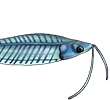Portnoy, DS, SJ O'Leary, AT Fields, CM Hollenbeck, RD Grubbs, CT Peterson, JM Gardiner, DH Adams, B Falterman, JM Drymon, JM Higgs, EL Pulster, TR Wiley & SA Murawski, 2024. Complex patterns of genetic population structure in the mouthbrooding marine catfish, Bagre marinus, in the Gulf of Mexico and U.S. Atlantic. Ecology and Evolution 14:e11514.
Abstract
Patterns of genetic variation reflect interactions among microevolutionary forces that vary in strength with changing demography. Here, patterns of variation within and among samples of the mouthbrooding gafftopsail catfish (Bagre marinus, Family Ariidae) captured in the U.S. Atlantic and throughout the Gulf of Mexico were analyzed using genomics to generate neutral and non-neutral SNP data sets. Because genomic resources are lacking for ariids, linkage disequilibrium network analysis was used to examine patterns of putatively adaptive variation. Finally, historical demographic parameters were estimated from site frequency spectra. The results show four differentiated groups, corresponding to the (1) U.S. Atlantic, and the (2) northeastern, (3) northwestern, and (4) southern Gulf of Mexico. The non-neutral data presented two contrasting signals of structure, one due to increases in diversity moving west to east and north to south, and another to increased heterozygosity in the Atlantic. Demographic analysis suggested that recently reduced long-term effective population size in the Atlantic is likely an important driver of patterns of genetic variation and is consistent with a known reduction in population size potentially due to an epizootic. Overall, patterns of genetic variation resemble that of other fishes that use the same estuarine habitats as nurseries, regardless of the presence/absence of a larval phase, supporting the idea that adult/juvenile behavior and habitat are important predictors of contemporary patterns of genetic structure.
Genetic population structure of gafftopsail catfish
- Silurus
- Posts: 12419
- Joined: 31 Dec 2002, 11:35
- I've donated: $12.00!
- My articles: 55
- My images: 893
- My catfish: 1
- My cats species list: 90 (i:1, k:0)
- Spotted: 424
- Location 1: Singapore
- Location 2: Moderator Emeritus





